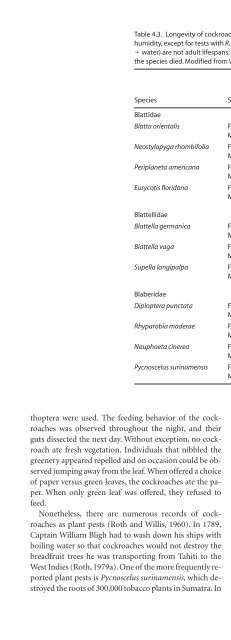Cockroache; Ecology, behavior & history - W.J. Bell
Cockroache; Ecology, behavior & history - W.J. Bell
Cockroache; Ecology, behavior & history - W.J. Bell
Create successful ePaper yourself
Turn your PDF publications into a flip-book with our unique Google optimized e-Paper software.
Table 4.3. Longevity of cockroaches on starvation diets.Tests were performed at 36–40% relative<br />
humidity, except for tests with R. maderae, which were run at 70%. Note that controls ( food,<br />
water) are not adult lifespans; controls were terminated when all the experimental insects of<br />
the species died. Modified from Willis and Lewis (1957).<br />
Mean length of survival (days)<br />
food food food food<br />
Species Sex water water water water<br />
Blattidae<br />
Blatta orientalis Female 64 16.8 32.1 14.2<br />
Male 40 11.5 20.0 11.9<br />
Neostylopyga rhombifolia Female 108 25.4 26.7 22.1<br />
Male 128 24.6 29.3 21.9<br />
Periplaneta americana Female 190 40.1 89.6 41.7<br />
Male 97 27.3 43.7 28.1<br />
Eurycotis floridana Female 86 26.6 43.0 26.7<br />
Male 70 21.8 29.7 21.1<br />
Blattellidae<br />
Blattella germanica Female 85 11.9 41.9 12.8<br />
Male 54 8.8 9.6 8.2<br />
Blattella vaga Female 95 7.9 32.4 8.5<br />
Male 69 5.4 16.8 4.8<br />
Supella longipalpa Female 80 12.8 14.3 14.5<br />
Male 74 11.5 10.1 9.0<br />
Blaberidae<br />
Diploptera punctata Female 102 18.7 42.9 18.7<br />
Male 119 14.5 28.9 15.8<br />
Rhyparobia maderae Female 181 160.0 54.3 51.3<br />
Male 150 84.0 56.0 35.1<br />
Nauphoeta cinerea Female 98 24.3 61.1 27.0<br />
Male 94 22.8 46.1 27.3<br />
Pycnoscelus surinamensis Female 139 18.8 73.2 24.3<br />
Male 74 9.9 39.8 10.6<br />
thoptera were used. The feeding <strong>behavior</strong> of the cockroaches<br />
was observed throughout the night, and their<br />
guts dissected the next day. Without exception, no cockroach<br />
ate fresh vegetation. Individuals that nibbled the<br />
greenery appeared repelled and on occasion could be observed<br />
jumping away from the leaf. When offered a choice<br />
of paper versus green leaves, the cockroaches ate the paper.<br />
When only green leaf was offered, they refused to<br />
feed.<br />
Nonetheless, there are numerous records of cockroaches<br />
as plant pests (Roth and Willis, 1960). In 1789,<br />
Captain William Bligh had to wash down his ships with<br />
boiling water so that cockroaches would not destroy the<br />
breadfruit trees he was transporting from Tahiti to the<br />
West Indies (Roth, 1979a). One of the more frequently reported<br />
plant pests is Pycnoscelus surinamensis, which destroyed<br />
the roots of 300,000 tobacco plants in Sumatra. In<br />
greenhouses, it is known to girdle rose bushes, eat the<br />
bark and stems of poinsettias, and damage orchids, cucumbers,<br />
and lilies. It was responsible for the destruction<br />
of 30,000–35,000 rose plants in one Philadelphia greenhouse,<br />
and regularly hollows the hearts of palms and<br />
ferns in the southern United States (Roth, 1979a). Apparently,<br />
it managed to sneak into Biosphere 2 and took a<br />
strong liking to every kind of living plant. Tomatoes,<br />
sweet potato leaves, flowers and fruit of squash plants,<br />
rice seedlings, ripe papayas and figs, and green sorghum<br />
seeds were each included on the bill of fare (Alling et al.,<br />
1993). While the culprit cockroach was never identified,<br />
both Pyc. surinamensis and P. australasiae were found in<br />
the beehives brought in to pollinate crops (Susan C.<br />
Jones, pers. comm. to CAN).<br />
The most commonly reported type of plant damage by<br />
cockroaches is to seedlings, new leaves, and growing root<br />
DIETS AND FORAGING 67


